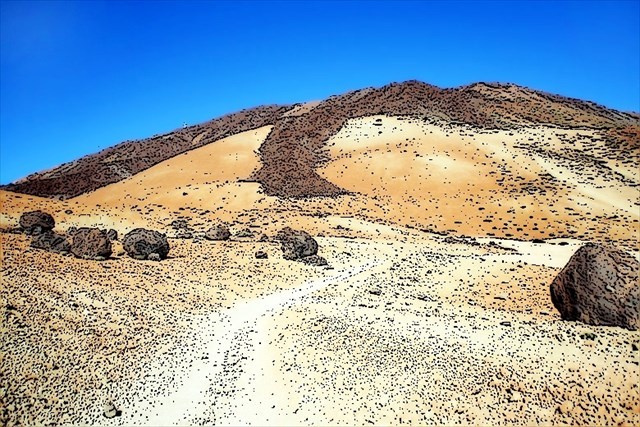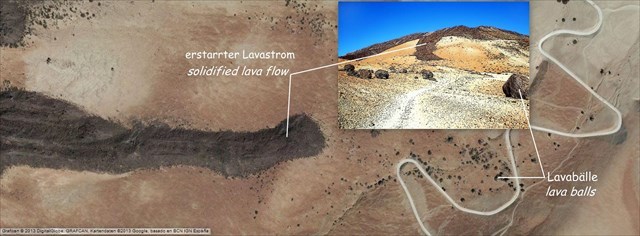Feld der Eier – Die Lavakugeln des Pico del Teide
Field of Eggs - Lava Balls of Pico del Teide
Achtung!
Ihr befindet euch in einem National Park, hier ist die gesamte Flora und Fauna geschützt, ebenso ist es nicht erlaubt Steine zu beschädigen oder zu sammeln!
Ein Besuch des Pico del Teide ist immer voller Gefahren! Bedenkt, dass es hier sehr heiß und trocken ist und im nächsten Moment das Wetter komplett umschwenken kann. Ihr müsst eine Wanderung in diesem Gebiet machen. Seid am besten nie allein unterwegs und nehmt immer genug zu Trinken mit.
Attention!
As in all national parks, all plants and animals, archeological features, and geological features (dirt, rocks, etc.) are protected. Please leave everything just as you found it. A visit to the Teide can be always full of danger! Considering that it is very hot and dry here and the next moment the weather can swing out completely. You have to take a walk in this area. Do not travel alone if you can help it. Still, it is wise to bring along your own water and food (you'll be out for a while).
Einleitung
Wo man sich auf Teneriffa auch befindet, man stößt immer wieder auf vulkanische und geologische Phänomene. Es ist aber auch nicht verwunderlich, da die Insel dem Vulkanismus ihre Entstehung verdankt. Der Pico del Teide ist mit 3718 Metern die höchste Erhebung auf der Kanarischen Insel Teneriffa und der höchste Berg auf spanischem Staatsgebiet. Der Teide ist der dritthöchste Inselvulkan der Erde. Er erhebt sich aus einer riesigen Caldera mit 17 Kilometer Durchmesser namens Las Cañadas. Der Teide selbst ist nicht in einem Schritt entstanden. Der Komplex Teide-Pico Viejo ist ein Schichtvulkan, der sich durch die Anhäufung von Material aufeinander folgender Eruptionen bildete. Obwohl schon viele geologische Phänomene dargestellt wurden, stellen alle eine Besonderheit zum Thema Vulkanismus dar. So auch das hier vorgestellte „Feld der Eier“.
Introduction
Everywhere you look in Tenerife you see volcanic and geological. It is also not surprising, since the island owes its origin to the volcanism. El Teide at 3718 meters is the highest point on the Canary Island of Tenerife and is the highest mountain on Spanish territory. The Teide is the third largest island volcano in the world. It rises from a huge caldera with 17 kilometers in diameter called Las Cañadas. The Teide itself was not created in one step. The complex Teide-Pico Viejo is a stratovolcano that was formed by the accumulation of material successive eruptions. Many geological phenomena have been shown to provide all a peculiarity about volcanism also represents the proposed, "field of eggs."

Entstehung des „Feld der Eier”
Ihr befindet euch hier auf ca. 2635 m über dem Meeresspiegel zwischen unzähligen und unterschiedlichen großen Kugeln aus Lava, den sogenannten Eiern des Teide (Huevos del Teide). Doch wie sind sie hier her gekommen? Zu ihrer Entstehung gibt es zwei Theorien.
Die eine Theorie besagt, dass es sich bei den Lavabällen um sogenannte vulkanische Bomben handelt. Eine vulkanische Bombe ist ein bei einem Vulkanausbruch ballistisch herausgeschleuderter Pyroklast, mit einem Durchmesser von mehr als 64mm. Er ist meist ei- oder spindelförmig, da sie sich während des Fluges und der Erkaltung in der Luft um ihre eigene Achse drehen. Die äußere Form und Oberfläche weisen Anzeichen auf, dass der Pyroklast während Entstehung und Transport geschmolzen war. Dies ist aber nicht der einzige Effekt der bei einem Vulkanaustritt entsteht. Ein anderes Naturschauspiel kann der Ausbruch von Lava sein und durch solch einen Lavastrom begründet sich die zweite Entstehungstheorie der Lavakugeln.
Die unterschiedlichen Erscheinungsformen der Lava sind Abhängig von den Bedingungen beim Aufstieg und der Abkühlung, diese entscheiden über die Temperatur und somit über die Viskosität der Lava. Beim Ausbruch des Pico del Teide wurden zwar auch vulkanische Bomben herausgeschleudert, die sich auf der ganzen Insel finden lassen, aber auch Massen an Lava. Einen dieser Lavaströme erblickt ihr hangaufwärts in Richtung des Teide. Es ist anzunehmen, dass es sich bei diesem Lavastrom um eine sogenannte ʻAʻā-Lava (Brockenlava) handelt. Diese ist eine zähflüssige basaltische Lava, die zu scharfkantigen Brocken und Klumpen erstarrt. Diese hat eine hohe Viskosität durch relativ rasche Abkühlung und Ausgasung. Während diese Lava allmählich den Krater hinunter floss lösten sich Teile dieser noch nicht vollständig verfestigten Lava und rollten auf dem Lavastrom den Hang hinunter. Durch ihre warme und klebrige Oberfläche nahmen sie immer mehr (vulkanisches) Gestein auf und wuchsen bis auf mehrere Meter Größe heran. Einen ähnlichen Effekt erzielt man mit Schnee beim Bau eines Schneemannes. Nach einer Weile kamen sie an einer flacheren Stelle zum Erliegen und bilden seit dem das Feld der Eier.
Formation of the "field of the eggs"
You find yourself here at about 2635 m above sea level between innumerable and different sized balls of lava, called Eggs of Teide (Huevos del Teide). But how are they get here? To their formation, there are two theories.
One theory holds that this lava balls are volcanic bombs. A volcanic bomb is in a volcanic eruption ejects viscous fragments of lava, with a diameter of more than 64mm. He is usually ovoid or spindle-shaped, as they rotate during the flight and the common cold in the air around its own axis. The external shape and surface have indications that the Tephra was melted during formation and transport. But this is not the only effect caused by a volcanic discharge. Another natural wonder, the eruption of lava and be justified by such a lava flow to the second theory of the origin of Lava balls.
The different forms of lava are dependent. Of the conditions during ascent and cooling, shall decide on the temperature, and hence the viscosity of the lava. The eruption of Mount Teide even volcanic bombs were thrown, which can be found all over the island, but also masses of lava. You behold one of these lava flows uphill towards the Teide. It can be assumed that it is in this lava flow is called ʻAʻā-lava (stony rough lava). This is high viscous basaltic lava, which solidifies into sharp chunks This has a high viscosity by relatively rapid cooling and out gassing. While this lava flowed slowly down the crater broke away parts of this not yet completely solidified lava and rolled on the lava flow down the slope. Through her warm and sticky surface, they took more and more (volcanic) rock and grew up to several yards of size. A similar effect is achieved with snow to build a snowman. After a while they came to stop at a shallower valley and the “field of eggs”.


Begebt euch zu dem „Feld der Eier“, beantwortet die folgenden Fragen und schickt uns hier die Antworten.
Ihr dürft gleich loggen, wenn es Probleme gibt dann melden wir uns.
Schön wäre es, wenn ihr auch ein Bild von euch / eurem GPS und der Lavabälle hochladen würdet.
Fragen:
1. Untersucht solch ein Ei und beschreibt uns das Gestein, insbesondere die Oberfläche.
2. Die Struktur einiger Eier verrät auch, warum die zweite Theorie wahrscheinlicher ist. Beschreibt diese und begründet eure Annahme.
3. Schaut euch um und überlegt welche Voraussetzung (neben einer bestimmten Viskosität der Lava) notwendig war, damit diese Lavabälle entstehen konnten?

Make your way to the “Field of Eggs”. Answer the following questions and send us the answers here.
You may login immediately. If there is a problem then we will contact you.
It would be great if you could upload a picture of you / your GPS along with the lava balls.
Questions:
1. Examines such an egg and we describe the rock, and in particular the surface.
2. The structure of some eggs also reveals why the second theory is more likely. Describes these reasons and your acceptance.
3. Look around you and consider what condition is necessary (in addition to a certain viscosity of lava), to created that lava balls?
Quellen / Bilder / weitergehende Informationen:
Sources / pictures / Futher literature:
- Feininger: Igneous Rocks: A Classification and Glossary of Terms (Recommendations of the IUGS Subcommission on the Systematics of Igneous Rocks)
- Murawski / Meyer: Geologisches Wörterbuch
- http://de.wikipedia.org/wiki/Teide
- http://de.wikipedia.org/wiki/Lava
- http://de.wikipedia.org/wiki/Vulkanische_Bombe
- http://www.geology.sdsu.edu/how_volcanoes_work/index.html
Happy Hunting wünschen


